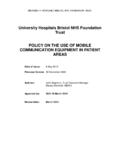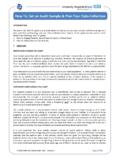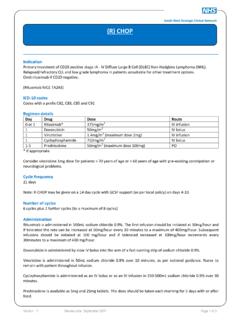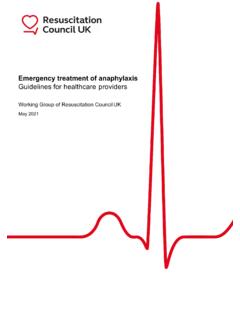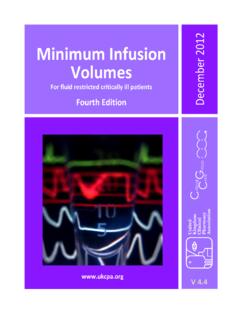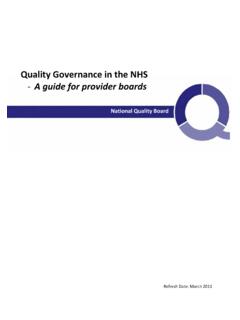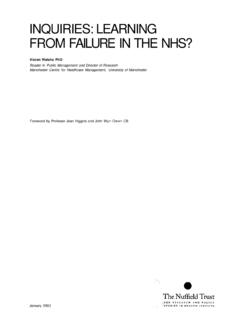Transcription of What is Clinical Audit? - University Hospitals Bristol NHS ...
1 2009 UHBristol Clinical Audit Team Version 3 Page 1 of 6 INTRODUCTION The aim of this guide is to provide a brief summary of what Clinical audit is and what it isn t. Aspects of this guide are covered in more detail in the following How To guides: How To: Choose and Prioritise Topics. How To: Set an Audit Sample & Plan Your Data Collection. How To: Engage Patients, Service Users & Carers in Clinical Audit. How To: Apply Ethics to Clinical Audit. WHAT IS Clinical AUDIT Clinical audit is a quality improvement process that seeks to improve patient care and outcomes through systematic review of care against explicit indicated, changes are further monitoring is used to confirm improvement in healthcare delivery.
2 Principles for Best Practice in Clinical Audit (2002, NICE/CHI) The key messages being that: 1. Clinical audit is not just a data collection exercise: It involves measuring current patient care and outcomes against explicit audit criteria (also termed standards). There is an expectation from the outset that practice will be improved. 2. Further Clinical audit may be required to confirm that practice has improved. The main stages of the Clinical audit process are: 1) Selecting a topic. 2) Agreeing standards of best practice (audit criteria).
3 3) Collecting data. 4) Analysing data against standards. 5) Feeding back results. 6) Discussing possible changes. 7) Implementing agreed changes. 8) Allowing time for changes to embed before re-auditing. 9) Collecting a second set of data. 10) Analysing the re-audit data. 11) Feeding back the re-audit results. 12) Discussing whether practice has improved. This process is called the Audit Cycle and is summarised in the diagram above. THE HISTORY OF Clinical AUDIT Medical audit undertaken by doctors was first formalised in 1989. Prior to this audit activity was isolated and infrequently undertaken.
4 Four years later, in 1993, Medical, Nursing and Therapy audit were brought together to form the multi-disciplinary activity that we now recognise as Clinical audit. What is Clinical Audit? Choose topic Agree / review standards Collect data on current practice Compare data with standards Implement change if needed 2009 UHBristol Clinical Audit Team Version 3 Page 2 of 6 What is Clinical Audit? Since 2008 there has been a shift in the national Clinical audit strategy, which has seen the reinvigoration of Clinical audit at a local level.
5 In line with this the Health Quality Improvement Partnership (HQIP) and the National Clinical Audit Advisory Group (NCAAG) have been tasked, by the Department of Health, to oversee national audits and to lead the reinvigoration of local Clinical audit by promoting quality in healthcare, and in particular increasing the impact that Clinical audit has on healthcare quality in England and Wales. At a local level Clinical audit links into both Clinical effectiveness and Clinical governance. Firstly, Clinical effectiveness aims to identify and appraise existing evidence of best practice.
6 Once identified, if necessary, local practice may be amended to ensure that it is conforming to best practice. Once implemented a Clinical audit project might be undertaken to ensure that: a. Best practice is being followed. b. That patient outcomes are the desired ones. Secondly, concerns regarding Clinical care are often identified through other Clinical governance structures. These concerns can often be used to inform a Clinical audit project. This includes: 1. User views or complaints. 2. Adverse incident/near miss reporting, aka Clinical /critical incident reporting.
7 3. Identified local priorities or concerns areas of high volume, risk or cost. WHAT Clinical AUDIT IS NOT Not all audit that takes place within the health service is Clinical audit. Clinical audit is a specific activity that measures Clinical care against explicit audit criteria (standards) as part of a quality improvement cycle. The term audit has a range of meanings and whilst people might want to audit something it does not necessarily mean that they are doing or want to do a Clinical audit project. Other forms of audit can include: Financial audit - Looking at accounts to establish whether they provide a true and fair view of the organisation's financial position at a given time.
8 Internal audit - An internal mechanism that traces non- Clinical activities and systems along 'audit paths' to see if things happened the way they should have. For example, tracing a patient complaint from the initial letter of complaint through to resolution to establish whether trust guidelines were followed appropriately. Organisational audit - An external, independent and voluntary audit of the whole organisation, based on a framework of explicit standards. Organisational audit looks at how well the organisation is set up and runs on a daily basis.
9 The King s Fund is an example of an independent service that undertakes organisational audits. Counting things/ Investigations - The collection of data which is not related to explicit audit criteria (standards) is not considered to be Clinical audit. Routine monitoring of Clinical outcomes - The identification and measurement of Clinical outcomes that are explicitly linked to the change process may form part of a Clinical audit project. However routine monitoring of outcome data for purposes such as performance monitoring is not considered to be Clinical audit.
10 Peer review including Mortality & Morbidity (M&M) - Peer review is a process whereby a group of clinicians collectively assess a small sample of patients recently under their care to establish whether the best possible care was provided or whether things might have been done differently. M&M reporting is a specific peer review process that looks at specific, non-random, cases with adverse outcomes, such as death or injury, to see what lessons can be drawn. Staff, patient, service user, carer surveys - Surveys are usually carried out as part of a research project or as an engagement activity.
